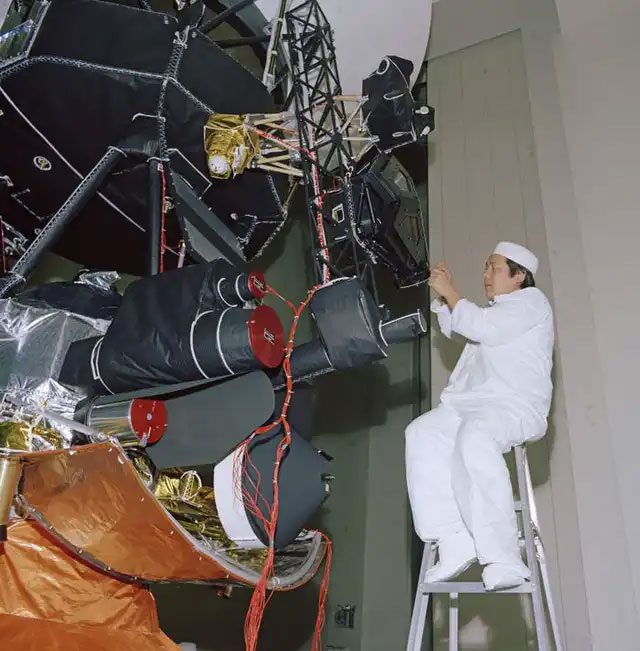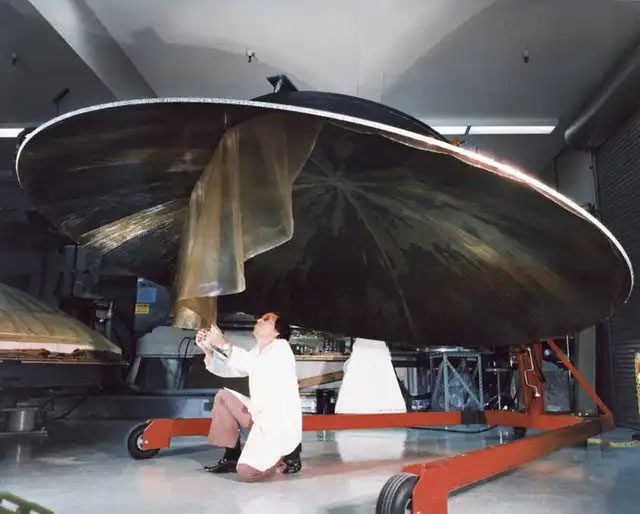In May, NASA scientists reported that the Voyager 1 spacecraft is sending back inaccurate data from its “attitude control system”. This mysterious issue is ongoing, according to the mission’s engineering team. To find a solution to the problem, engineers are having to revisit and study the spacecraft’s operating manuals from 45 years ago.
Voyager 1 and its “twin sister” Voyager 2 were launched in 1977 with the original goal of conducting a grand tour, studying Jupiter, Saturn, Uranus, Neptune, and their respective moons.
After nearly 45 years in space, both spacecraft are still operational. In 2012, Voyager 1 became the first human-made object to cross the boundary of the Sun’s influence. It is currently about 23.3 billion kilometers from Earth, sending data back to our planet from beyond the Solar System.
Suzanne Dodd, project manager for the Voyager mission at NASA’s Jet Propulsion Laboratory, shared, “No one thought it would last this long.”

An engineer working on equipment for one of NASA’s Voyager spacecraft on November 18, 1976.
Voyager 1 was designed and built in the early 1970s, and to date, the current engineers of the Voyager mission have only a few documents related to the spacecraft – command media, technical jargon for paperwork containing details about the spacecraft’s design and procedures – from the early days of the mission, while other important documents may have been lost or misplaced.
Voyager 1 was built by the Jet Propulsion Laboratory. The spacecraft has a hollow hexagonal body with 10 compartments on its edges to house electronic equipment, while the hollow center is used to place the fuel tank. The spacecraft is equipped with 11 scientific instruments to study objects such as planets as it flies by.
During the first 12 years of the Voyager mission, thousands of engineers worked on the project, according to Dodd. “When they retired in the 70s and 80s, the scientific community seemed to have ‘forgotten’ to establish a project document library. Consequently, engineers inadvertently took project-related documents home with them along with their personal belongings when they left,” Dodd added. In modern missions, NASA has learned from this experience and strives to maintain records and documents in a more systematic and scientific manner.
For the latest issue with Voyager 1, mission engineers had to specifically search for related documents based on the names of the engineers who helped design the attitude control system. “It’s a time-consuming process,” Dodd said.

An engineer working on a large dish antenna of Voyager on July 9, 1976.
So far, the Voyager engineers have not been able to pinpoint the root cause of the malfunction, mainly because they have not been able to reset the system, Dodd said. Currently, the mission’s engineering team believes that the fault may partly stem from the spacecraft’s “aging” – “Not everything lasts forever, even in space.”
The radio communication system of Voyager 1 is designed to operate beyond the Solar System. The system includes a 3.7-meter diameter dish antenna with a high gain used to transmit and receive radio waves from three Deep Space Network stations on Earth. The spacecraft transmits data to Earth via channel 18 of the Deep Space Network, using frequencies of 2.3 GHz (S-band) and 8.4 GHz (X-band). Signals from Earth are sent to Voyager 1 at a frequency of 2.1 GHz.
Additionally, many observations suggest that the spacecraft’s issues may also be influenced by its position in interstellar space. According to Dodd, the spacecraft’s data indicates that high-energy charged particles are present in interstellar space. “It’s unlikely that these particles will collide with the spacecraft, but if it happens, it could damage the spacecraft’s electronics,” Dodd said, “We cannot be certain that this is the source of the anomaly, but it could be a factor.”
When Voyager 1 cannot communicate directly with Earth, its Digital Tape Recorders (DTR) can store about 64 kilobytes of data to transmit back to Earth at a later time. In February 2016, it took 37 hours for a signal from Voyager 1 to reach Earth.
Despite the spacecraft’s orientation issues, Voyager 1 continues to receive and execute commands from Earth, and its antenna remains pointed towards us. Dodd stated, “We do not see any decrease in signal strength.”
Due to its considerable age, NASA engineers have implemented various measures to manage Voyager 1’s power with the hope that it can remain operational until 2030.
Throughout its operational years, Voyager 1 has provided us with invaluable data, from discovering unknown moons and rings to the first direct evidence of anomalous physical phenomena. The Voyager mission has helped scientists gain a better understanding of the universe. Dodd stated, “We want the mission to last as long as possible because it provides us with a wealth of very valuable scientific data.”
“It’s remarkable that both spacecraft of the mission are still operational and functioning well – although there are currently some glitches, both are still sending back a lot of valuable data,” Dodd said.





















































